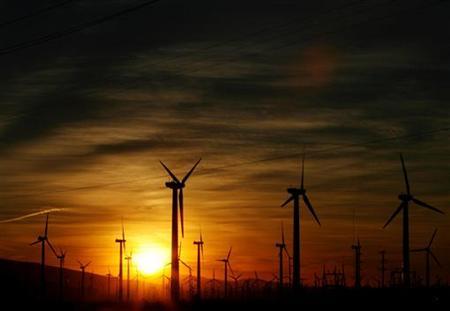Huge offshore wind farms can protect vulnerable coastal cities against devastating cyclones like Katrina and Sandy by tempering winds and ocean surges before they reach land, a study said Wednesday.
Had such installations existed at the time, Hurricane Katrina which ravaged New Orleans in 2005, and Sandy, which smashed the coastlines of New York and New Jersey in 2012, would have been reduced to strong but not devastating winds, it said.
"The little turbines can fight back the beast," said Cristina Archer, an associate professor of Earth sciences at the University of Delaware.
The study, published in the journal Nature Climate Change, is the first to demonstrate that wind farms, deployed on a grand scale, can buffer violent hurricanes, the researchers said.
The team simulated the impact from farms of tens of thousands of turbines, placed kilometres (miles) offshore and along the coast of cyclone-vulnerable cities.
They found that turbine blades extracting energy from the wind on a very large scale can have a marked effect on the internal dynamics of a cyclone.
"We found that when wind turbines are present, they slow down the outer rotation winds of a hurricane," said Mark Jacobson, a professor of civil and environmental engineering at Stanford University in California.
"This feeds back to decrease wave height, which reduces movement of air toward the centre of the hurricane, increasing the central pressure -- which in turn slows the winds of the entire hurricane and dissipates it faster."
Wind speed, storm surge are braked
In the case of Hurricane Katrina, sustained peak wind speed would have been reduced by as much as 44 metres per second (158 kilometres or 98 miles per hour).
The storm blew maximum gusts, but not sustained peaks, of about 282 kph (175 mph), according to the National Oceanographic and Atmospheric Administration (NOAA), a US government agency.
Katrina's storm surge -- waves whipped up by the exceptional winds -- would have abated by up to 79 percent, said the study.
In the case of Tropical Storm Sandy, the model projected a drop of up to 140 kph (87 mph) in sustained peak wind speed and a 34-percent decrease in storm surge.
When Sandy, at an earlier stage, was rated as a powerful Category 3 hurricane, it packed gusts of up to 185 kph (115 mph).
According to the study, the turbines should not be damaged and would continue to produce power during these events.
By taming the leading edge of the storm, they would also dissipate the buildup of the winds that followed.
As a result, the wind speed would not exceed the turbines' designed cutout speed -- a threshold that prompts the device to go into lockdown and feather its blades to prevent damage.
The turbine arrays used in the simulation were gigantic -- 78,000 machines generating more than 300 gigawatts of electricity.
This is thousands of times the size of the biggest offshore wind farm in the world today -- the London Array in southeastern England, which has 175 turbines.
But, according to the study, these mega-farms would pay for themselves by generating electricity in addition to providing storm protection.
A 32-km (20-mile) installation off the New York coast would cost about $210 billion (153 billion euros) to build.
By way of comparison, Tropical Storm Sandy inflicted about $80 billion (58 billion euros) in damage when it hit three states in 2012.
The disaster spawned plans to build higher sea walls to shield New York from rising storm surges expected from climate change -- a project that carries estimated costs of between $10-29 billion but produces no revenue.



















































